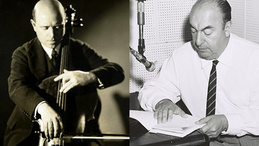 Marie Arana, author and Senior Adviser to the U.S. Librarian of Congress, moderated the well blended multimedia conversation, at the Kennedy Center on Friday evening, about three Pablos; Neruda, Picasso and Casals who established permanent footsteps in the Spanish speaking world and beyond, with their innovative and sometimes revolutionary perspectives within the realms of poetry, painting and music. All three passed away in the year of 1973. And their lives were delved into as a, "true nexus of the arts," Arana stated. "The men were contemporaries and friends who lived and worked during a politically charged time," she said. Arana described Pablo Neruda, of Chile as, "a literary master who taught Latin Americans who they were," and in a short film, the poet is revealed to be a person who cut across class and political boundaries to bring his message to the world. Neruda says of himself, "I'm a human being above all else and I've made many mistakes." Julia Alvarez, author and literary scholar describes Neruda and her love for his poetry that came while receiving her MFA, and how she found that the poetry of Neruda did not directly translate into English but needed to be read in its Spanish form. There was a theme that language is not just a method of communication but is a home. Dr. Marilyn McCully, who is a known scholar on the life and works of Picasso, spoke of a man who was born with unique talent and first presented his work, to acclaim through the press, at the age of thirteen. He was greatly influenced by El Greco (Doménikos Theotokópoulos) and Francisco Goya, with Spanish culture having a constant impact on the dynamic and mediums of his works. McCully delved into how Picasso was known in life, for his dark moods and intense eyes. He had a series of women, sometimes overlapping, and rarely, if ever liked to live alone. The film of Picasso, composed by Ruth Schell, was wryly amusing, showing him, an elderly man wearing only shorts, beginning to paint on a wall a mural with a dove. Workers came the next day and thought it was an unimportant sketch and took it down to Picasso's irate sensibilities. McCully delves into the many definitions of Picasso's work including; modernist, cubist, Africanist, as well as neoclassicist and indeed there is an amazing variety to his work. Marta Casals Istomin, Artistic Director of the Kennedy Center from 1980 to 1990, and widow of Pablo Casals gave a vivid view of a man who played and taught the cello with passion and integrity to equal degree. Her husband's public concerts were largely affected by political discourse including from the two Great World Wars. The Song of the Birds reflecting a request for peace, is mentioned as a favorite work. A film of Casals, also composed by Schell, shows him as a middle aged man teaching a student to play his cello in a way that gives both the cello and all the music from it, a sense of life. Then there are scenes of horror, women running with bloodied children in their arms, from the Spanish Civil War that began in 1936. Casals spoke of how once one is affected by such a violence, one's life and music is made to prevent such happenings from occurring again and as politics bled into art, Casals refused to play in concert under Francisco Franco. His widow carries on his legacy in preserving his memory and she lends his Matteo Goffriller cello (1700) to those worthy of playing it. The evening closed with Saint-Saëns Allegro Appassionato, Op. 43, J.S. Bach's Aria from Organ Pastoral in F Major, BVW 590, and Popper's Tarantella for Cello and Piano, Op. 33; played by Amit Peled and Members of the Peabody Institute. By Sarah Bahl 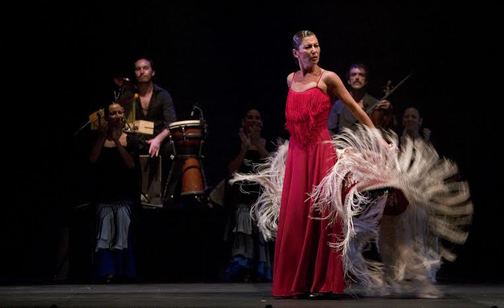 Sara Baras, Image by Peter Muller Sara Baras, Image by Peter Muller Sara Baras; artistic director, choreographer, and lead dancer for the Voces, Suite Flamenca at the Kennedy Center on Monday evening, gave a debut performance that was heralded with a standing ovation. Flamenco was joined with theater and words, both recorded and sung live, to place various arts and make them intricately tied together. Keko Baldomero, composed music with instruments including guitar, saxophone, drums and tambourine that communicated mood through changes in rhythm and tempo which either paralleled or juxtaposed the dancer's movements at all times. Sometimes Baras would tap in the exact same measure as the guitar beats, which was astounding to perceive. At other times, the dance was meant to compete against the musical rhythms whereby dancer and instrument vied against each other. The scenes began with a lone dancer in black shirt and pants with a white jacket, and as she crossed the stage pictures behind her of men and women, larger than life, in postures enjoying the world of flamenco, lit up as she passed. The imagery conveyed a connection with the past and respect for those who both have been and are creators and actors within the world of flamenco. Taranta, danced by Baras, was guided by the words of Antonio Gades: I think that man, that human beings have to have the dignity to take full advantage of themselves. This is not the profession to make you rich, or to make you better looking or for you to be praised in, it is a profession in which you represent a culture and you represent a very fine work, and whether it's art or not you'll see later...and why people dance is being forgotten; people used to dance through a state of emotion; because they were sad, because they were happy, because they wanted to fight. For that they danced. Personal perspectives were heralded throughout the event and the past was brought into the future as Enrique's Morente's words reflected during Farruca: I don't think that art should have restrictions; art must have freedom, everything is possible and what matters is the result...flamenco at the same time that it's becoming more and more universal is also becoming bigger and bigger. We mustn't be pessimistic, we must be optimistic and encourage the younger generation...I much prefer being free than being tightly squeezed into a square shaped peg that says nothing and passes nothing on to others. After the ovation there came a personal note from Ms. Baras that she has won a gold medal for her flamenco work, from the King of Spain and she has it on her heart. The evening ended with baile de mantón, by the corps performers lead by Baras in a long bright green layered fringe dress. By Sarah Bahl 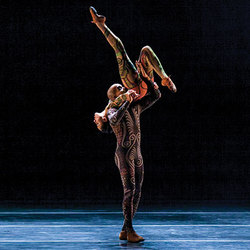 Grupo Corpo Grupo Corpo The opening night celebrating Iberian Suite at the Kennedy Center began with a piano piece by Javier Perianes that was elegant, intricate and simple at the same time. Light notes played into deeper and more demanding fare that lead back to a playful, spring-like end. The work then changed to a beautiful video montage with images of the natural world and words reflective of personal qualities found in Iberian culture. (The microphone stand, in the left corner, though made of clear material, was noticeable through a couple of scenes.) Eugenia León, known as the voice of Mexico, gave off an earthy vibrance with her piece, that resounded with hope and pain. The subtle natural quality was also found in the ballet work of Carmen and Ángel Corella, the latter's costume dress being a natural beige color that blended with her skin and graced all her movements with perfect fluidity. Ángel was simple in black pants and shirt. Their ballet was for the first half, made of low movements close to the ground, with Carmen's flamenco to break the cohesion from earth bound motions to higher jeté and pirouettes. The dancers moved within a uniquely mellow harmony, with a sense of long practiced symmetry. The dancers of Grupo Corpo from Brazil, were amazing with earth based core movements in intricate unison, while wearing costumes that really looked like they could be painted skin, with red-browned and earth colored skirts for both the men and women. The scenes continued with video montage, poetry and a commemoration for the beauty in all its forms of Iberian culture. By Sarah Bahl 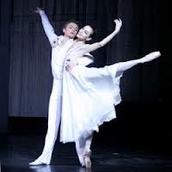 The Mariinsky Ballet performed Prokofiev's Cinderella, from October 16th to the 21st, at the Kennedy Center. This performance was in a manner; stark, urban, and modernized. The background set, reminded me, in its drab plainness of the set from the movie, West Side Story. Act I begins with the evil Stepmother and Stepsisters getting their hair done against a bare warehouse style background. The Stepmother and Stepsisters are larger than the petite and lovely Cinderella. Their clothes consist mainly of ugly neon concoctions or baggy shapeless items, that are of marked difference to Cinderella's flowing, pale, graceful ensemble. The Stepmother and Stepsisters leave for the ball and Cinderella is transformed by an old haggard drone, (really a faery in disguise) into a beautiful lady. The drone does this by pulling the needed items: dress and slippers, out of an old ratty bag. Some of the scenes confused me, because in order to show the faery, warning Cinderella of her fate if she does not return before midnight, Cinderella dances out the fate, collapses to the ground and the curtain is pulled. I did not realize this was symbolic of future pretense. The realities of Cinderella's collapse, either eluded me or were not portrayed clearly. Act II begins at the ball, where the characters and meaning are simpler. The dancers' movements are puppeteered in unison to the point of comedy. The audience laughed repeatedly during Act II as throughout all acts, for the ballet movements often took on a playful cartoonish quality. At least for all the characters except the consistently elegant Cinderella and her Prince Charming. Cinderella is gorgeous - in white - and dances with her Prince Charming. She leaves at midnight, leaving behind her one glass slipper... By Sarah Bahl 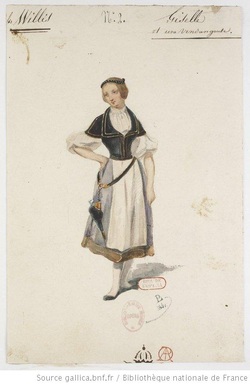 A rendition of Giselle (1841) A rendition of Giselle (1841) To escape to the Kennedy Center in morbidly hot weather is a gift of itself. The plush red carpet is comforting and the hum of persons being shuttled in an orderly fashion to their seats is part of the veneer. Giselle being performed by the Paris Opera Ballet at the Kennedy Center is a gem to see. According to, La Maison Française’s information letter, the Paris Opera Ballet has not been to the Nation’s Capitol in 19 years. The ballet runs through the 8th. The First Act of the story begins with bright and natural woodland scenery. The floor is kept a simple wood and the costumes are elegant and rustic to reveal the simple peasant Giselle (danced by Isabelle Ciaravola). Her dress adds to the quaint rhythms of the peasants' motions as they celebrate the harvest. There are two men in Giselle’s life. One who she accepts and the other, she keeps at a distance. Her preferred man is Prince Albrecht of Silesia, who, tired of court life decides to dress as a peasant and woo the lovely and innocent Giselle. Her jealous suitor, the Gamekeeper Hilarion, unmasks Prince Albrecht, and in doing so reveals Albrecht to be already engaged to the noblewoman Bathilde, (dressed in highly refined and lushly embroidered costume to starkly contrast with Giselle being herself.) The sensitive Giselle dances to reveal her confusion and pain. She dies from the pain of her lost love and the competing men nearly duel over her. 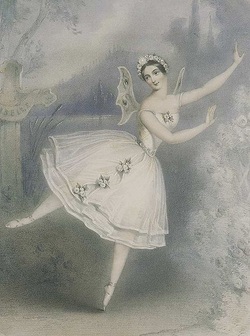 Carlotta Grisi as Giselle (1841) Original Source Unknown Carlotta Grisi as Giselle (1841) Original Source Unknown The Second Act, is absolutely beautiful in an otherworldly manner, with a darkened woodland scene, as Giselle, now deceased has joined The Wilis, the spirits of young women, with the misfortune of death brought upon them before being wed. The dancers, in white spirit garb, are all the same height, and dance in unison to celebrate their current fate within the black woodland night. The Wilis enact revenge for their broken hearts by wooing young men into their world, never to return. Their first victim is Hilarion. Then, it would be Albrecht, as well, except Giselle convinces the other spirits to let him go, because she still likes him so much. And so the story ends. Giselle returns to her world and Albrecht remains within his own, much as it all began. The original costumes represented are by Paul Lormier, for the ballet’s initial 1841 production. At the time, Romanticism was in high fashion among the general populace in France and the costumes and ideals behind the ballet marketed to this particular niche. Lormier did much historical study to create as realistic a garb as possible. The current costumes represent the spirit of his work. By Sarah C. Bahl |
Archives
June 2017
Categories
All
|
 RSS Feed
RSS Feed